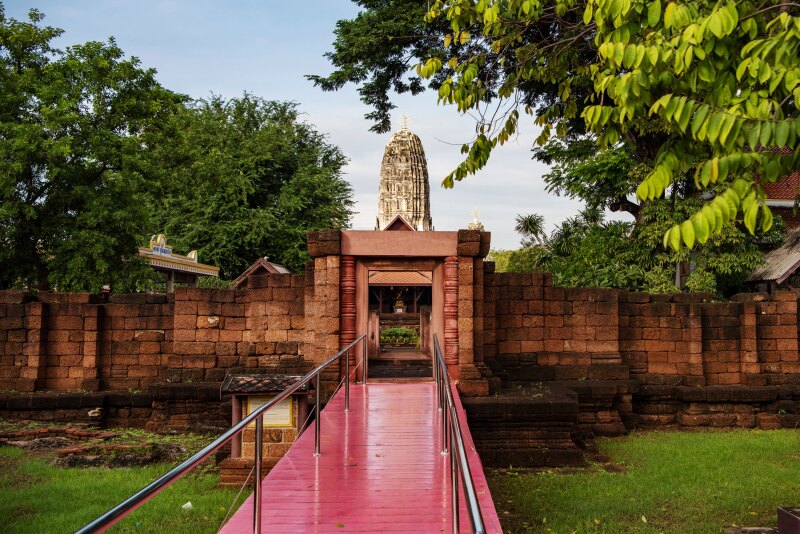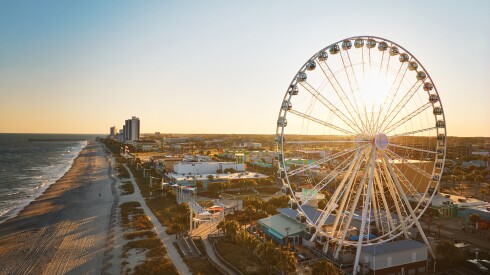Bangkok’s Grand Palace shimmered gold in the Thai morning, making me catch my breath upon first sight—but I was immediately distracted. The ancient, uneven tiles on the ground, though they added historic charm, felt like a relentless tremor in my wheelchair. The unpredictable terrain beneath my wheels shook my entire body, so that even keeping my head upright became a struggle, and our kind tour guide, Neng, had to steady my forehead. Momentarily missing out on the beauty of the complex, I wondered for a moment if I could physically manage the rest of my planned adventures in Thailand.
In addition to temples, much of my 12-day itinerary through Bangkok, Kanchanaburi, and Hua Hin would take place outside. Though I love nothing more than immersing myself in nature, venturing into the great outdoors can be challenging, especially for my 400-pound power wheelchair. I’m usually able to find some wheelchair-accessible trails in national parks within the U.S., but when I travel internationally, those options are often more limited. Having not even left the capital city of Bangkok yet, I started to grow worried.
However, Thailand ended up being full of surprises. My concerns were eased by the company helping to arrange my trip.
“Our mission is to position Thailand as a global leader in inclusive tourism,” says Nutty Nithi Subhongsang, owner of accessibility-focused tour company Nutty’s Adventures, which also operates across southeast Asia. “By specializing in accessible tours, we aim to empower travelers with disabilities, ensuring they can experience Thailand with ease, dignity, and joy.”
More companies such as this are growing their operations, including Panda Phuket Tour and Help & Care Travel Co., Ltd. The Thai government has also been investing in more accessible infrastructure the past few years. Due to those combined efforts, I encountered several outdoor adventures that left me hovering over water, face-to-face with elephants, and in awe of my personal interaction with Thailand.
A warm greeting came upon arrival at Regent Cha Am Beach Resort in Hua Hin. Approximately 2.5 hours south of Bangkok, Hua Hin is a charming coastal town with long beaches, gorgeous parks, and a blend of history and modernity. The resort’s accessible rooms are quite standard, but easily manageable and spacious. There are also multiple restaurants, a spa, and a platform fairly close to the sea so that wheelchair users can take in the amazing views.
I then headed to my first outing at Bueng Bua, a shallow marsh in Khao Sam Roi Yot National Park, full of blooming lotus flowers, wading herons, and graceful egrets. Spanning across the watery haven is a kilometer-long boardwalk made of smooth, wooden planks, comfortably wide enough for my wheelchair. One could easily spend an hour here enjoying the peaceful ambiance and stunning mountain vistas beyond, all just 40 minutes from Hua Hin.
Finding one accessible outdoor path on a trip is a win; having two options in the same vicinity is incredible. Next up was the Sirinath Rajini Mangrove Forest, with its intricate root systems on full display above ground—a true marvel of nature. A kilometer-long route blends harmoniously with the natural terrain, meandering through dense plant life. Yet the path itself is even, uninterrupted, and effortless to navigate in a wheelchair. Interpretive signs along the trail highlight the ecological significance of mangroves for coastal resilience and biodiversity. Such thoughtful designs create an intimate atmosphere for spotting water monitor lizards and diverse birdlife like black-faced spoonbills.

Visitors to Elephants World in Kanchanaburi can guide the animals to mud baths, river bathing, and meal time.
Photo by Lee Kai Wai/Shutterstock
Still to come was my most anticipated activity in Thailand: seeing wild elephants. The challenge would be finding a sanctuary that is both wheelchair accessible and ethical. I knew I wanted to choose a place where the humans work for the animals, not the other way around. I learned about Elephants World, located in Kanchanaburi, from my guide, Neng.
Cofounded by a veterinarian, the sanctuary rescues elderly, disabled, and injured elephants, some of whom were previously exploited at logging or trekking camps. Over the course of four hours, I fed around a dozen elephants, made food for them, and learned about how they live. Paved paths allowed me to get up close and personal with the enormous creatures. Though there were some steep ramps in certain areas, the Elephants World staff assisted me whenever necessary.
Any trip to Thailand isn’t complete without visiting temples, and as I learned in my research leading up to my travels, accessibility can be hit-or-miss at different wats around the country. I visited several temples over the weeks, but my favorite was Wat Mahathat in Ayutthaya, about an hour’s drive from Bangkok. This Buddhist temple complex dates back to the 14th century, yet its paths are still smooth today, and it’s been outfitted with ramps, so I had no issues getting around. The ruins are spread across open-air grounds, so I soaked up sunlight while wandering to different stupas, statues, and the iconic Buddha head entwined within the roots of a banyan tree.

Wheelchair-friendly ramps at Wat Mahathat help make Thailand’s cultural heritage universally accessible.
Photo by amnat30/Shutterstock
One of the best parts of my trip was being in the moment, without worrying whether I would get through the experience. Not only did Nutty’s Adventures secure accessible hotels and private guides, they also arranged adapted transportation and even scouted restaurants before the trip. A growing number of such companies, along with Thailand’s inclusive initiatives, are helping make the country’s cultural heritage universally accessible. “Travel should be inclusive,” says Nithi, “ensuring everyone, regardless of mobility or sensory limitations, can experience the beauty and culture of Thailand without barriers.”











